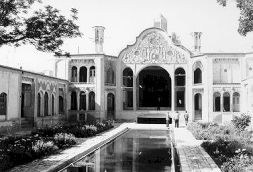 |
Kashan |
| Kashan:
Bagh-è Tarikhi-ye Fin |
Geographical status:
Longitude: 51, 27
Latitude: 33, 59
Altitude: 950 m above sea level
Average annual temperature:
Diagram for mean annual temperature(1994)
Hottest month:
coldest month:
Average annual precipitation: mm
Maximum precipitation in one day: mm
Average relation humidity: morning: noon:
Average number of freezing day: day
Population(1996): 335,785
Baghshah-e Fin and Cheshmeh Solaymanieh (Solaymanieh Spring)
This garden is known as one of the most beautiful old gardens
in Iran. It has been prized for its Solaymanieh
spring water flowing, plenty of old trees, numerous natural
springs and ponds. The Solaymanieh spring
(Cheshmeh Solaymanieh), which pours out of Kuh Dandaneh mountain
located 7 kilometers southwest of
Kashan
city is known as one of the earliest underground water reserves
in
Iran.
The buildings in Fin garden which include two structures belonging
to Shah Abbas and Fath Ali Shah and a
building attributed to Karimkhan and a bath (the bath is famous
since Amir Kabir was killed there), are
examples of the architecture of various eras including
the Safavids
(1499-1723 ),
Zandieh
(1750-1891 ) and
Qajar
(1785-1886 ) all combined to form an outstanding collection.
Seyalk Hills
Seyalk hills are located 3 kilometers from southwest of
Kashan.
The discoveries made in the Seyalk hills of
Kashan
in 1937 and 1938 indicate that about 4500 BC some relatively
civilized ethnic groups who used stone
and bones as their tools were stationed in that region. In
4200 BC the lifestyle of these people developed in a
manner observed in the style, kind, design and color of the
dishes they used to make. It seems that the original
inhabitants of this region were overcome by the newly immigrated
tribes and nations whose dishes enjoyed a
black background using red clay. The artistic manifestations
of these tribes which penetrated into such
regions as suburbs of
Tehran,
Cheshmeh Ali,
Ray,
Ismaeil Abad and Shahryar hills have been already
unearthed. (4000 - 3800 BC).
Since then and concurrent with the arrival of new nations,
the northern hills turn deserted and the southern
hills develop and represent the future Seyalk civilizations.
The most important discoveries in this region
include Elamite clay tablets. These tablets show that 5500
years ago, as a result of the relationship
established between these tribes and nations with the civilization
of Shusha, they learnt how to write Elamite.
Numerous clay tablets with such caligraphy have been discovered
in Seyalk which have been entitled
cemetery A and cemetery B. The works produced by the tribes
who lived in the second millenium have been
unearthed from the cemetery A and those produced in late second
millenium and early first milenium from
cemetery B of the Seyalk hills. The items discovered in cemetery
B belong to the newly arrived immigrants
and are very much like the items unearthed from Gian hill
in
Nahavand,
Khorvin hill in Savoj Bolagh, Hasanloo
hills in
Naqadeh,
Goy Tappeh and some regions in
Lorestan province.
|
























